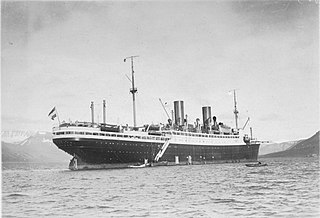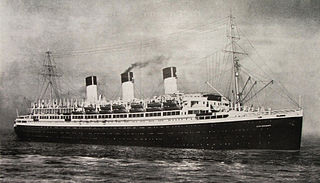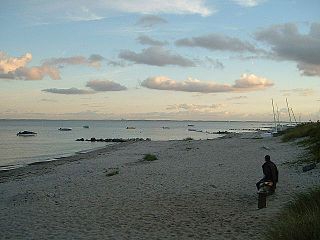
SS General von Steuben was a German passenger liner and later an armed transport ship of the German Navy that was sunk in the Baltic Sea during World War II. She was launched in 1923 as München, renamed General von Steuben in 1930, and renamed Steuben in 1938.

An ocean liner is a type of passenger ship primarily used for transportation across seas or oceans. Ocean liners may also carry cargo or mail, and may sometimes be used for other purposes. Only one ocean liner remains in service today.

Neuengamme was a network of Nazi concentration camps in Northern Germany that consisted of the main camp, Neuengamme, and more than 85 satellite camps. Established in 1938 near the village of Neuengamme in the Bergedorf district of Hamburg, the Neuengamme camp became the largest concentration camp in Northwest Germany. Over 100,000 prisoners came through Neuengamme and its subcamps, 24 of which were for women. The verified death toll is 42,900: 14,000 in the main camp, 12,800 in the subcamps, and 16,100 in the death marches and bombings during the final weeks of World War II. Following Germany's defeat in 1945, the British Army used the site as an internment camp for SS and other Nazi officials. In 1948, the British transferred the land to the Free Hanseatic City of Hamburg, which summarily demolished the camp's wooden barracks and built in its stead a prison cell block, converting the former concentration camp site into two state prisons operated by the Hamburg authorities from 1950 to 2004. Following protests by various groups of survivors and allies, the site now serves as a memorial. It is situated 15 km southeast of the centre of Hamburg.

SS Cap Arcona, named after Cape Arkona on the island of Rügen, was a large German ocean liner, later a ship of the Kriegsmarine, and finally a prison ship. A flagship of the Hamburg Südamerikanische Dampfschifffahrts-Gesellschaft, she made her maiden voyage on 29 October 1927, carrying passengers and cargo between Germany and the east coast of South America, and for a brief period of time she was the largest and fastest ship on the route, until one month later she was surpassed on the same Europe-South America route by the Italian liner MS Augustus.

The Bay of Lübeck is a basin in the southwestern Baltic Sea, off the shores of the German states of Mecklenburg-Vorpommern and Schleswig-Holstein. It forms the southwestern part of the Bay of Mecklenburg.

A troopship is a ship used to carry soldiers, either in peacetime or wartime. Troopships were often drafted from commercial shipping fleets, and were unable to land troops directly on shore, typically loading and unloading at a seaport or onto smaller vessels, either tenders or barges.

SS Europa, later SS Liberté IMO 5607332, was a German ocean liner built for the Norddeutsche Lloyd line (NDL) to work the transatlantic sea route. Launched in 1928, she and her sister ship, Bremen, were the two most advanced, high-speed steam turbine ocean vessels in their day, with both earning the Blue Riband.
Thielbek was a 2,815 GRT cargo steamship that was built in Germany in 1940, sunk in an air raid in 1945, refloated in 1949 and repaired, and was in service until 1974. Lübecker Maschinenbau Gesellschaft in Lübeck built her in 1940 for the Knöhr and Burchard shipping company of Hamburg. In 1961 Knöhr and Burchard sold her to buyers who renamed her Magdalene and registered her in Panama. In 1965 she was renamed Old Warrior. She was scrapped in Yugoslavia in 1974.

Köln was a light cruiser, the third member of the Königsberg class that was operated between 1929 and March 1945, including service in World War II. She was operated by two German navies, the Reichsmarine and the Kriegsmarine. She had two sister ships, Königsberg and Karlsruhe. Köln was built by the Reichsmarinewerft in Wilhelmshaven; she was laid down in August 1926, launched in May 1928, and commissioned into the Reichsmarine on 15 January 1930. She was armed with a main battery of nine 15 cm SK C/25 (5.9-inch) guns in three triple turrets and had a top speed of 32 knots.

Neustadt in Holstein is a town in the district of Ostholstein, in Schleswig-Holstein, Germany, on the Bay of Lübeck 30 km northeast of Lübeck, and 50 km southeast of Kiel.

German submarine U-48 was a Type VIIB U-boat of Nazi Germany's Kriegsmarine during World War II, and the most successful that was commissioned. During her two years of active service, U-48 sank 51 ships for a total of 299,477 GRT and 1,060 tons; she also damaged four more for a total of 27,877 GRT over twelve war patrols conducted during the opening stages of the Battle of the Atlantic.

SS Justicia was a British troop ship that was launched in Ireland in 1914 and sunk off County Donegal in 1918. She was designed and launched as the transatlantic liner Statendam, a new flagship for the Holland America Line (NASM), but the outbreak of First World War delayed her completion. In 1915 NASM agreed to let the United Kingdom acquire her and have her completed as a troop ship.

SS Pasteur was a steam turbine ocean liner built for Compagnie de Navigation Sud-Atlantique. She later sailed as Bremen for Norddeutscher Lloyd. In the course of her career, she sailed for 41 years under four names and six countries' flags.

A four-funnel liner, also known as a four-stacker, is an ocean liner with four funnels.

Dieppe was a steam passenger ferry that was built in 1905 for the London, Brighton and South Coast Railway. She was requisitioned during the First World War for use as a troopship and later as a hospital ship HMS Dieppe, returning to her owners postwar. She passed to the Southern Railway on 1 January 1923. In 1933 she was sold to W E Guinness and converted to a private diesel yacht, Rosaura. She was requisitioned in the Second World War for use as an armed boarding vessel, HMS Rosaura. She struck a mine and sank off Tobruk, Libya on 18 March 1941.

Sam Pivnik was a Holocaust survivor, author and memoirist. He was the second son of Lajb Pivnik, a tailor, and Feigel Pivnik. As a Jewish family, the Pivniks were forced to live in the Kamionka Ghetto in Będzin from early 1943, and on 6 August 1943 the family were deported to Auschwitz II-Birkenau. His parents, younger sister Chana and younger brothers Meir, Wolf and Josef, were murdered on arrival. His older sister Hendla survived for a brief period before she was sent to be gassed.

SS Cap Polonio was a German 20,576 GRT ocean liner that was launched in 1914 and scrapped in 1935. She worked the Hamburg Südamerikanische Dampfschifffahrtsgesellschaft route between Hamburg in Germany and Buenos Aires in Argentina. She was named after Cabo Polonio in Uruguay.

The Bay of Neustadt or Neustadt Bay is a sub-bay within the Bay of Lübeck which, in turn, is part of the Bay of Mecklenburg in the Baltic Sea.

RMS Asturias was a Royal Mail Lines ocean liner that was built in Belfast in 1925. She served in the Second World War as an armed merchant cruiser until she was crippled by a torpedo in 1943. She was out of action until 1948 when she returned to civilian service as an emigrant ship. She became a troop ship in 1954 and was scrapped in 1957.
Benjamin Jacobs, born Bronek Jakubowicz or Berek Jakubowicz, was a dentist who in 1941, was deported from his Polish village and remained a Nazi prisoner until the final days of the Second World War. He survived Auschwitz and the death march to the Baltic, with the help of his dental tools.


















